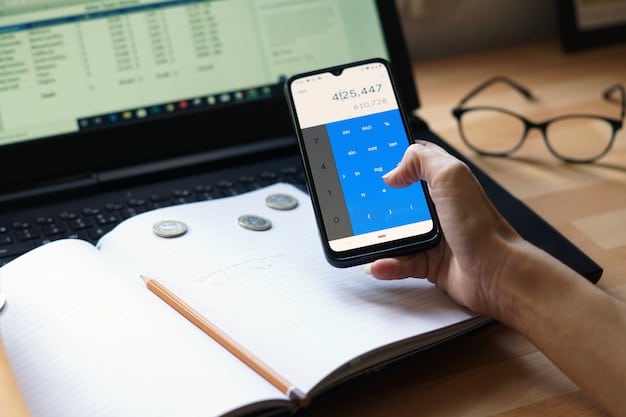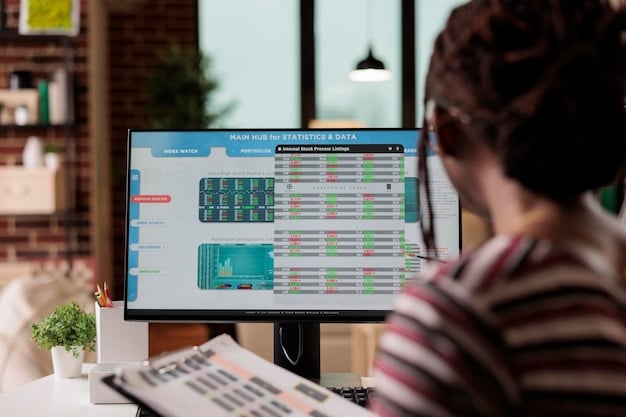Track Your Spending: The Best Ways to Improve Your Finances

Anúncios
Tracking your spending is crucial for identifying areas where you can cut back, save more effectively, and ultimately improve your overall financial health, leading to better money management.
Want to get a grip on your finances? **The best ways to track your spending and identify areas for improvement** involve a mix of methods, from simple budgeting apps to detailed spreadsheets, helping you understand where your money goes and how to save more.
Anúncios
Why Tracking Your Spending is Essential
Understanding where your money goes is the first step towards financial control. By tracking your spending, you gain insights into your spending habits, which can reveal areas where you’re overspending or making unnecessary purchases. This awareness is crucial for making informed decisions and achieving your financial goals.
Tracking your spending isn’t just about cutting costs; it’s about aligning your spending with your values and priorities. When you know where your money is going, you can make conscious choices to spend on things that truly matter to you and eliminate expenses that don’t bring value to your life.
Anúncios
Identifying Spending Patterns
Tracking helps you see patterns. Are you spending too much on eating out or subscriptions?
- Are impulse buys eating into your budget?
- Knowing this allows targeted adjustments.
- Regular reviews prevent overspending.
Understanding these patterns is vital for making sustainable financial changes and achieving long-term financial stability.

Effective Methods for Tracking Your Spending
There’s no one-size-fits-all approach to tracking expenses. Different methods appeal to different personalities and lifestyles. Whether you prefer the simplicity of a notebook or the sophistication of a budgeting app, the key is to find a method that you can consistently use.
Consider your preferences and habits when choosing a tracking method. Do you prefer manual methods, or do you prefer the convenience of digital tools? Experiment with different options until you find one that fits seamlessly into your daily routine.
Budgeting Apps
Apps like Mint and YNAB streamline the process. Automatic categorization and insights save time.
Spreadsheets
Excel or Google Sheets offer customisation. Create categories and track trends manually.
- Tailored categories suit specific needs.
- Manual entry ensures accuracy.
- Visualisations aid understanding trends.
By finding the right method, you can easily track your spending and gain valuable insights into your financial behavior.
Utilising Budgeting Apps for Expense Tracking
Budgeting apps have become increasingly popular for their convenience and comprehensive features. These apps automate many aspects of expense tracking, making it easier to monitor your spending and identify areas for improvement. They often provide real-time insights, helping you stay on top of your finances.
Many budgeting apps also offer additional features, such as goal setting, bill tracking, and investment monitoring. These features can help you manage your finances holistically and achieve your financial goals more effectively.
Benefits of Using Budgeting Apps
These apps provide several advantages. Easy tracking, automated categorization, and visual reports are key
They can automatically link your bank accounts and credit cards, making expense tracking effortless. They categorise your transactions, providing you with an overview of where your money is going.
- Real-time insights improve decision-making.
- Automated tracking saves significant time.
- Visual reports offer easy understanding.
Whether you’re looking to save for a down payment on a house or pay off debt, budgeting apps can help you stay on track.

Creating a Spreadsheet for Budget Management
For those who prefer a hands-on approach, creating a spreadsheet can be an effective way to track spending and manage your budget. Spreadsheets offer a high degree of customization, allowing you to tailor your tracking system to your specific needs and preferences.
Setting up a spreadsheet may require more initial effort than using a budgeting app, but it offers greater control over your data and analysis. You can create custom categories, formulas, and visualizations to gain deeper insights into your spending habits.
Customising Your Spreadsheet
Personalize your spreadsheet with categories. Regular expense reviews ensure accuracy and control.
Start by listing all your income sources and recurring expenses, such as rent, utilities, and loan payments and create columns for each expense category you want to track, such as groceries, transportation, and entertainment.
- Regular reviews prevent overspending.
- Custom reports enable detailed analysis.
- Formulas automate calculations.
By customizing your spreadsheet, you can gain a more detailed understanding of your financial situation.
Analysing Your Spending Data for Improvement
Tracking your spending is only useful if you take the time to analyse the data and identify areas where you can make improvements. Look for patterns and trends that reveal opportunities to cut back on unnecessary expenses or redirect funds towards your financial goals.
Regularly review your spending data to identify areas where you can make the most significant impact. Consider setting specific, measurable, achievable, relevant, and time-bound (SMART) goals to guide your efforts.
Setting Financial Goals
Set clear objectives for direction. Review spending to identify saving opportunities.
Define your financial objectives. Aim to save specific amounts monthly to help reach financial goals.
- SMART goals provide clear direction.
- Regular reviews maximise savings.
- Achievable goals motivate progress.
Whether you’re saving for retirement, paying off debt, or building an emergency fund, setting SMART financial goals can help you stay motivated and on track.
Implementing Strategies to Reduce Expenses
Once you’ve identified areas where you can cut back on expenses, it’s time to put strategies into action. Look for creative ways to reduce your spending without sacrificing your quality of life. Make small changes can add up to significant savings over time.
Review your spending data find areas where you can cut back. From negotiating bills to automating savings.
Negotiate better deals on utilities, shop around for insurance, and cancel unused subscriptions. Automate your savings to ensure you’re consistently putting money away towards your financial goals.
- Smart choices save money.
- Negotiate bills for better deals.
- Automate transfers to savings.
By implementing these strategies, you can reduce your expenses and accelerate your progress towards financial freedom ensuring.
| Key Point | Brief Description |
|---|---|
| 💰 Track Spending | Monitor expenses to identify unnecessary spending. |
| 📊 Analyse Data | Review spending patterns for potential savings. |
| 🎯 Set Goals | Establish clear financial objectives. |
| 💸 Reduce Expenses | Implement strategies to cut unnecessary spending. |
Frequently Asked Questions
▼
Tracking spending helps you understand where your money goes, enabling you to identify areas for improvement and make informed financial decisions and improve your **money management** skills.
▼
Effective methods include using budgeting apps, creating spreadsheets, or using a simple notebook to record expenses, depending on your preference and lifestyle.
▼
Budgeting apps streamline the process by automating expense categorization, providing real-time insights, and generating visual reports to help you monitor your **spending**.
▼
Spreadsheets offer customisation, allowing tailored tracking and comprehensive analysis of income and expenses, giving you greater control over your financial data.
▼
Regularly reviewing your data, such as weekly or monthly, helps you to identify patterns, reduce expenses, and ensure you stick to your financial goals for better **money management**.
Conclusion
Tracking your spending is a fundamental practice for effective **money management**. By adopting the right methods, analyzing your data, setting financial goals, and implementing strategies to reduce expenses, you can gain greater control over your finances and achieve long-term financial stability.





